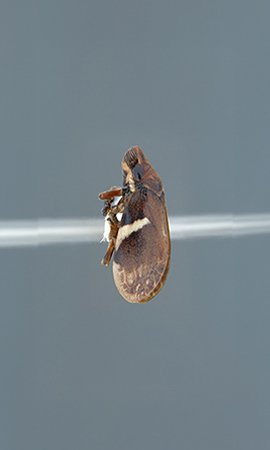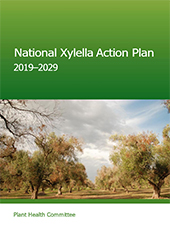The bacteria Xylella is Australia’s number 1 pest threat.
There are over 700 plant host species including native, commercial and ornamental plants.
The National Xylella Action Plan 2019–2029 is a nationally agreed approach to:
- prevent Xylella and its exotic vectors
- prepare for a response if a pest is detected in Australia.
Success of the plan depends on collaboration between stakeholders. These include:
- importers
- shipping businesses
- agricultural industries
- Australian, state and territory governments
- non-government organisations
- individuals
- experts and research agencies.
National Xylella Action Plan 2019-2029
What it covers
The National Xylella Action Plan covers bacterial pathogens of the Xylella genus. This includes Xylella fastidiosa.
The plan also includes confirmed and unconfirmed exotic vectors. Example insects that may spread the bacteria include:
- Acrogonia terminalis
- Dilobopterus costalimai
- Oncometopia fascialis
- sharpshooter leafhopper (Acrogonia citrina)
- green leafhopper (Cicadella viridis)
- green sharpshooter (Draeculacephala minerva)
- blue-green sharpshooter (Graphocephala atropunctata)
- glassy winged sharpshooter (Homalodisca vitripennis)
- spittle, meadow froghopper (Philaenus spumarius)
- redheaded sharpshooter (Xyphon fulgidum).
Pest and disease details
Implementation schedule
Each national action plan has an implementation schedule for actions and projects.
The National Xylella Action Plan has outlined over 60 projects and business-as-usual activities. This plan will improve our preparedness for Xylella and exotic vectors.
Xylella Implementation Schedule 2023
Action areas
The National Xylella Action Plan focuses on these 4 action areas:
- prevention
- detection
- response
- cross-cutting, which contains actions that fit into 2 or more of the first 3 areas.
Projects and activities
Example areas that projects and activities focus on include:
- pest risk assessments
- communication and training
- research into vectors and plant hosts
- improving diagnostic tests and tools
- testing surveillance methods and response protocol.
Activities are reviewed annually to document progress.
Research highlight

Identifying native insect vectors of Xylella
The Xylella bacteria can be spread from one plant to another by insects known as vectors.
The Xylella insect vectors project aims to understand which native Australian and New Zealand insects might vector (carry and spread) Xylella.
The project studied over 20,000 insects collected in the field. Over 5,000 were from museum and government reference collections. It identified the common native Australian spittlebug insect (Bathyllus albicinctus) as a potential vector.
Knowledge of native Xylella vectors will help us to better respond to the disease.
We worked with Hort Innovation, Agriculture Victoria, NSW Department of Primary Industries, Macquarie University, and Wine Australia on this project.
Image credit: Agriculture Victoria
Completed projects
Area: Detection
- Improving preparedness of the Australian horticultural sector to the threat potentially posed by Xylella fastidiosa
- Boosting diagnostic capacity for plant production industries
- Developing rapid, accurate and field deployable diagnostics.
Area: Response
Area: Cross-cutting
- Draft pest risk analysis for bacterial pathogens in the genus Xylella
- Xylella coordinator to help protect Australia’s horticulture and wine sectors.
- Economic impacts of Xylella fastidiosa on the Australian wine grape and wine making industries.
- Protecting Australia’s horticultural industries from disease: The impacts of Xylella fastidiosa on Australian horticulture and the environment.
Get involved
Are you a researcher, industry member or interested person? If you’d like to get involved email us at plantpestpreparedness@aff.gov.au.
Subscribe
Keep up to date with our biosecurity news.


